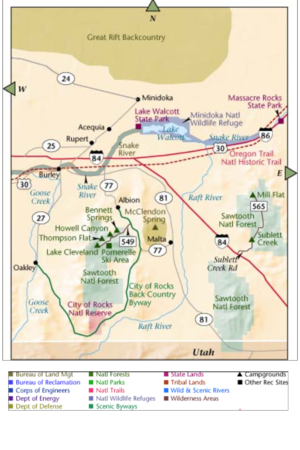
Minidoka Dam
Encyclopedia

Snake River
The Snake is a major river of the greater Pacific Northwest in the United States. At long, it is the largest tributary of the Columbia River, the largest North American river that empties into the Pacific Ocean...
in south central Idaho
Idaho
Idaho is a state in the Rocky Mountain area of the United States. The state's largest city and capital is Boise. Residents are called "Idahoans". Idaho was admitted to the Union on July 3, 1890, as the 43rd state....
. The dam, originally completed in 1906, is east of Rupert
Rupert, Idaho
Rupert is the county seat and largest city of Minidoka County, Idaho, United States. It is part of the Burley, Idaho Micropolitan Statistical Area...
on county highway 400; it is 86 feet (26 m) high and nearly a mile (1.6 km) in length, with a 2400 feet (731.5 m) wide overflow spillway section. The dam and power plant were listed on the National Register of Historic Places
National Register of Historic Places
The National Register of Historic Places is the United States government's official list of districts, sites, buildings, structures, and objects deemed worthy of preservation...
in 1974. Walcott Park, close to the dam, is a popular summertime picnic area. The headquarters for the Minidoka National Wildlife Refuge
Minidoka National Wildlife Refuge
Minidoka National Wildlife Refuge is located on the Snake River Plain in south-central Idaho, northeast of Rupert. It includes about of shoreline around Lake Walcott, from Minidoka Dam upstream about ....
are adjacent to the dam.
History
The Minidoka dam was the first Reclamation Service project in Idaho, part of the Minidoka ProjectMinidoka Project
The Minidoka Project is a series of public works by the U.S. Bureau of Reclamation to control the flow of the Snake River in Wyoming and Idaho, supplying irrigation water to farmlands in Idaho...
of dams, reservoirs and canals. Construction began in 1904 and by 1906 most of the dam's canals and laterals were finished. By 1909, Minidoka Dam's power plant, the first federal power plant in the northwest, was completed. By its completion, the total cost of the dam was $5.8 million, which exceeded estimates. The Minidoka project brought water into the southeastern areas of Idaho near the cities of Rupert
Rupert, Idaho
Rupert is the county seat and largest city of Minidoka County, Idaho, United States. It is part of the Burley, Idaho Micropolitan Statistical Area...
and Burley
Burley, Idaho
Burley is a city in Cassia and Minidoka counties in the southern portion of the U.S. state of Idaho. The population was 10,345 at the 2010 census. The city is the county seat of Cassia County....
. The project was successful, as what was once an uninhabited sagebrush desert is now bountiful farmland. The powerplant installation was significant as a precursor of much larger projects on the Columbia River
Columbia River
The Columbia River is the largest river in the Pacific Northwest region of North America. The river rises in the Rocky Mountains of British Columbia, Canada, flows northwest and then south into the U.S. state of Washington, then turns west to form most of the border between Washington and the state...
, including Bonneville Dam
Bonneville Dam
Bonneville Lock and Dam consists of several run-of-the-river dam structures that together complete a span of the Columbia River between the U.S. states of Oregon and Washington at River Mile 146.1. The dam is located east of Portland, Oregon, in the Columbia River Gorge. The primary functions of...
.
A study examining the possibility of raising the crest of the dam by 5 feet (1.5 m) was conducted from 2000 to 2009, but with costs ranging from $150 million to $205 million the project has not been pursued. A $50 million spillway repair project is expected to go ahead.
Power plant
The Minidoka Dam was initially designed and constructed without power generation facilities, but the Minidoka power plant was soon added in 1909-1910. It was designed to generate electricity for pumping operations to support irrigation on the south bank of the Snake River. While irrigation water could flow by gravity to the north bank, water for the south bank had to be raised to a higer elevation. Units 1-5 generated power using propellor-style units., but did not efficiently use the water volume passing through the dam. Unit 6, a 3MW unit with a Francis turbine, was added in 1927, with the 5.5 MW Unit 7 added in 1942. Units 1 - 5 were retired in 1995, before the construction of the Allen E. Inman Powerplant in 1997. The new plant houses Unit 8 and 9, each with a 10MW Kaplan horizontal unit. The original plant housing Units 1 -5 has been preserved and is listed on the National Register of Historic Places.Excess power from the original powerplant was sold to local farmers, making the Minidoka area one of the first rural areas to have an electric power distribution system.
Statistics
- Provides supplemental water supply to more than 1 million acres (4000 km²) of land.
- The reservoir has a storage capacity of 210000 acre.ft.
- The reservoir, Lake WalcottLake WalcottLake Walcott is a reservoir in south central Idaho in the northwestern United States, impounded by Minidoka Dam. The damming of the Snake River by the Minidoka Project formed the 11,000 acre lake beginning in 1909. "Bird Island" is an island in the lake. Lake Walcott is used for water-sports and...
, is named after a Bureau of Reclamation engineer. - The reservoir extends 26 miles (42 km) up the Snake River and has a shoreline of 80 miles (130 km).

